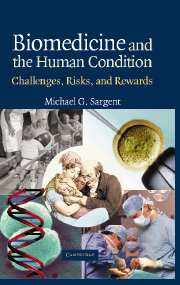Book contents
- Frontmatter
- Contents
- Preface
- 1 Challenges, Risks, and Rewards: Learning to Control Our Biological Fate
- 2 Learning to Breed Successfully
- 3 How Life is Handed On
- 4 Cells in Sickness and Health
- 5 Experiences in Utero Affect Later Life
- 6 Infection, Nutrition, and Poisons: Avoiding an Unhealthy Life
- 7 Signs of Ageing: When Renovation Slows
- 8 Cancer and the Body Plan: A Darwinian Struggle
- 9 Fighting Infection
- 10 Are Devastating Epidemics Still Possible?
- 11 Discovering Medicines: Infinite Variety through Chemistry
- 12 Protein Medicines from Gene Technology
- 13 Refurbishing the Body
- 14 Living with the Genetic Legacy
- 15 Epilogue: Signposts to “Wonderland”
- References
- Index
3 - How Life is Handed On
Published online by Cambridge University Press: 06 August 2009
- Frontmatter
- Contents
- Preface
- 1 Challenges, Risks, and Rewards: Learning to Control Our Biological Fate
- 2 Learning to Breed Successfully
- 3 How Life is Handed On
- 4 Cells in Sickness and Health
- 5 Experiences in Utero Affect Later Life
- 6 Infection, Nutrition, and Poisons: Avoiding an Unhealthy Life
- 7 Signs of Ageing: When Renovation Slows
- 8 Cancer and the Body Plan: A Darwinian Struggle
- 9 Fighting Infection
- 10 Are Devastating Epidemics Still Possible?
- 11 Discovering Medicines: Infinite Variety through Chemistry
- 12 Protein Medicines from Gene Technology
- 13 Refurbishing the Body
- 14 Living with the Genetic Legacy
- 15 Epilogue: Signposts to “Wonderland”
- References
- Index
Summary
The twentieth century will be remembered as the era when mankind first glimpsed an answer to life's most thought-provoking question: How is life handed on? The key, unknown until fifty years ago, lies in the singular chemical character of DNA (or, in a few cases, RNA), from which every inheritable feature of every organism originates. DNA can replicate to allow genetic information to be passed on to each succeeding generation and is also the primary template for making the protein products in almost every living organism. Most of our genetic information originates in chromosomes selected from the parental sets, but specific maternal and paternal contributions also exist.
DNA Transmits Genetic Information
Once scientists started to understand how the characteristics of animals and plants were inherited, they inevitably wondered what part of a cell carried genetic information. The answer to this profoundly important question came from an unexpected quarter – a lowly pneumonia-causing microbe called Pneumococcus – and the penetrating insight of a clinical pathologist, Fred Griffith, in London in 1929. In order to understand his esoteric discovery, one needs to know that disease-causing Pneumococci, when cultured in a bacteriologist's Petri dish, grow as smooth slimy-looking colonies; colonies of harmless strains have a rough appearance. Griffith's interest was aroused by the curious outcome of an experiment. Mice had been injected with the “rough” harmless variety of Pneumococcus together with sterilised cells of the “smooth,” disease-causing version of the same bug.
- Type
- Chapter
- Information
- Biomedicine and the Human ConditionChallenges, Risks, and Rewards, pp. 45 - 68Publisher: Cambridge University PressPrint publication year: 2005



